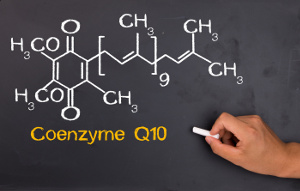Patients with hereditary hemochromatosis lack Q10
- and supplements may have therapeutic value
 Hereditary hemochromatosis is a group of diseases that involve iron accumulation in the body. This leads to oxidative stress and tissue destruction which may affect the liver and other organs. According to a new Argentinian study, patients with hereditary hemochromatosis lack Q10 in their blood. Because Q10 is of vital importance to the cellular energy turnover and it also serves as a powerful antioxidant against oxidative stress, a Q10 deficiency will contribute to the disease. This, the researchers behind the new study explain, is why Q10 may represent a new and safe agent for treating the condition.
Hereditary hemochromatosis is a group of diseases that involve iron accumulation in the body. This leads to oxidative stress and tissue destruction which may affect the liver and other organs. According to a new Argentinian study, patients with hereditary hemochromatosis lack Q10 in their blood. Because Q10 is of vital importance to the cellular energy turnover and it also serves as a powerful antioxidant against oxidative stress, a Q10 deficiency will contribute to the disease. This, the researchers behind the new study explain, is why Q10 may represent a new and safe agent for treating the condition.
Hereditary hemochromatosis is a group of diseases that all involve accumulation of iron in the body, primarily in the liver, the skin, the joints, and the pancreas. The flawed gene is called HFE and must be passed on from both parents in order to trigger the disease in their offspring. The liver is the organ that stores the highest quantity of iron, which is why this organ is normally attacked first. Excess iron levels can cause liver cirrhosis and liver cancer (hepatocellular carcinoma) if the condition is not treated.
Iron is an essential mineral that is particularly important for the hemoglobin in blood that carries oxygen to all our cells. However, having too much iron in the body can cause the mineral to generate free radical formation. Free radicals are highly reactive and potentially damaging molecules.
Free radicals are normally generated as a waste product of the oxygen metabolism and other metabolic processes. In order to prevent these molecules from damaging cells and their DNA, it is important to keep the free radicals on a tight leash. Otherwise, you risk oxidative stress, an imbalance between harmful free radicals and protective antioxidants.
Coenzyme Q10 happens to be one of the most important antioxidants. It is also of vital importance to the energy production in cells that takes place inside the mitochondria. It is believed that Q10 represents the first line of defense by protecting lipids, cells, and cellular DNA against oxidative stress. Moreover, Q10 is able to restore vitamin E’s antioxidant activity. Therefore, lack of Q10 is considered an early marker of both oxidative stress and various metabolic disruptions.
Humans are able to synthesize most of their own Q10 but the endogenous Q10 synthesis decreases with age. Coenzyme Q10 deficiency can be categorized as “primary deficiency” or “secondary deficiency”. Secondary Q10 deficiencies have been observed in many hereditary diseases that are characterized by oxidative stress.
There is growing evidence of early Q10 therapy as having a positive effect on secondary deficiency diseases such as muscle ailments, neurodegenerative diseases, cardiovascular diseases, impaired fertility, and cancer.
In the new study, the researchers wanted to measure blood levels of Q10 in patients with hemochromatosis and also look at how this correlated with different disease markers.
Significant Q10 deficiency in all phases of the disease
The researchers are affiliated with Universidad de Buenos Aires and Hospital de Clinicas José de San Martin in Buenos Aires, Argentina. A total of 38 patients (32 men and six women) took part in the study. All had recently been diagnosed with hemochromatosis. The researchers collected blood samples to measure levels of Q10, iron, ferritin, transferrin, and vitamins A, C, and E. In addition, the patients’ liver function was tested (transaminase, alkaline phosphatase, and bilirubin), and tests of tissue samples and three mutated genes were also conducted. The control group consisted of 25 healthy controls (22 men and three women) without clinical signs of having too much iron or liver disease of any kind.
It turned out that all patients with hemochromatosis had significantly lower levels of Q10 compared with the healthy control group. No difference was detected in levels of vitamin A and vitamin C in the two groups. However, patients with hemochromatosis had significantly lower levels of vitamin E.
Q10 supplementation could be a new and safe therapy form
According to the scientists, the lack of Q10 in patients with hemochromatosis suggests that Q10 supplementation could represents a safe and potentially useful strategy if given in combination with conventional therapies. Taking Q10 can reduce oxidative stress and the tissue damage that is caused by this condition. At the same time, Q10 boosts the effect of vitamin E.
The new study is published in Clinics and Research in Hepatology and Gastroenterology. Although Q10 supplements may hold promise as a useful add-on therapy, it is important to make absolutely sure that the quality of the supplements is acceptably high. In Q10 as a raw material, the Q10 molecules aggregate and form crystals that are unable to pass through the intestinal wall and enter into the blood. Unless these crystals are properly dissolved, the body cannot absorb the active ingredient. A patented method that involves using vegetable oils with different melting points and a special heating process has been shown to make coenzyme Q10 fully absorbable. Always make sure to choose pharmaceutical-grade coenzyme Q10 with documented bioavailability.
Reference:
Manuela R. Martinefski et al. Coenzyme Q10 deficiency in patients with heredity hemochromatosis. Clinics and Research in Hepatology and Gastroenterology 45 (2021) www.sciencedirect.com
Lain Hargreaves et al. Disorders of Human Coenzyme Q10 Metabolism: An Overview. International Journal of Molecular Sciences. 2020
Will Chu. Co enzyme Q10 has potential to help chronic condition symptoms, review finds. NUTRAingredients.com 2020
Search for more information...
- Created on .








